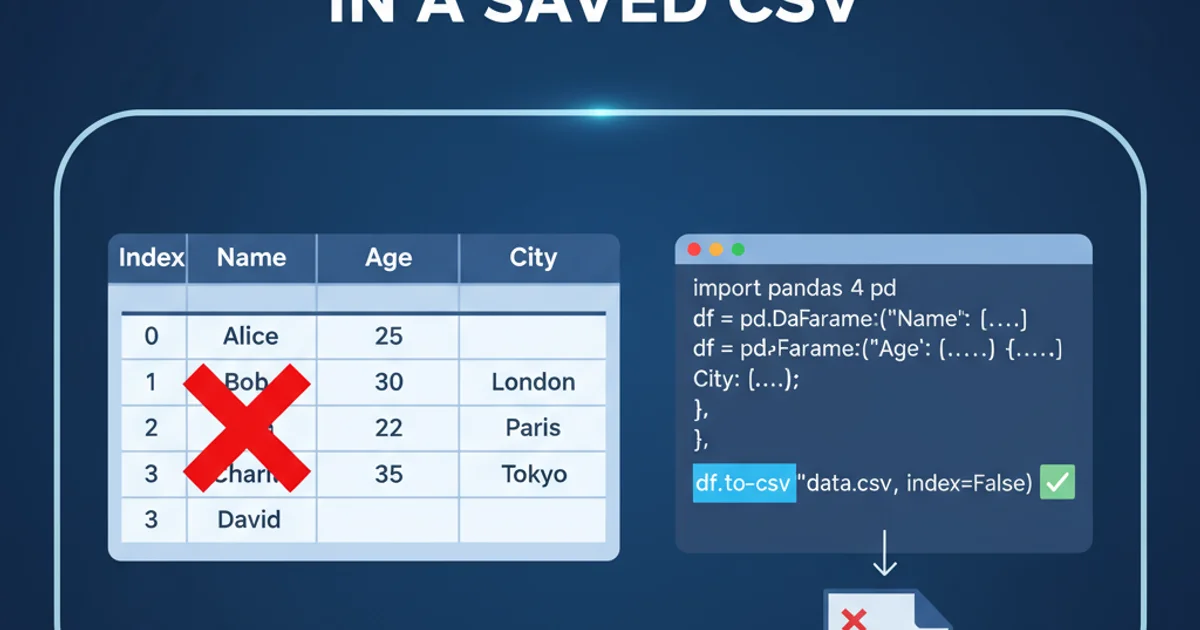How to avoid pandas creating an index in a saved csv
Categories:
Preventing Pandas from Writing the Index to CSV Files

Learn how to efficiently save Pandas DataFrames to CSV without including the default index column, ensuring clean and usable data exports.
When working with data in Python, Pandas DataFrames are an indispensable tool. However, a common pitfall for new and even experienced users is the automatic inclusion of a DataFrame's index as the first column when saving to a CSV file. This often leads to redundant data, parsing issues, and unnecessary cleanup steps in subsequent data processing. This article will guide you through the simple yet crucial methods to prevent Pandas from writing this index to your CSV files, ensuring your exports are clean and ready for immediate use.
Understanding the Pandas Index
Every Pandas DataFrame has an index, which is a sequence of labels (by default, integers starting from 0) used to identify each row. While incredibly useful for data alignment, selection, and manipulation within Pandas, this internal identifier is rarely needed when exporting data to a flat file format like CSV. Including it can create an extra, often unnamed, column in your CSV, which can be confusing and require manual removal later.
flowchart TD
A[Pandas DataFrame] --> B{"to_csv() method"}
B --> C{Include Index?}
C -- Yes --> D[CSV with Index Column]
C -- No --> E[CSV without Index Column]Decision flow for including the index when saving to CSV.
The index=False Parameter
The most straightforward and widely used method to prevent the index from being written to a CSV file is to use the index=False parameter within the to_csv() method. This parameter explicitly tells Pandas to omit the DataFrame's index from the output file. It's a simple addition that makes a significant difference in the cleanliness of your exported data.
import pandas as pd
# Create a sample DataFrame
data = {'Name': ['Alice', 'Bob', 'Charlie'],
'Age': [25, 30, 35],
'City': ['New York', 'London', 'Paris']}
df = pd.DataFrame(data)
print("Original DataFrame:")
print(df)
# Save DataFrame to CSV without the index
df.to_csv('my_data_no_index.csv', index=False)
print("\nDataFrame saved to 'my_data_no_index.csv' without index.")
# To verify, you can read it back:
# df_read = pd.read_csv('my_data_no_index.csv')
# print("\nRead back DataFrame:")
# print(df_read)
Example of saving a Pandas DataFrame to CSV using index=False.
index=False a habit when exporting DataFrames to CSV unless you specifically need the index as a data column. This prevents downstream issues and keeps your data exports clean.Handling MultiIndex DataFrames
If your DataFrame has a MultiIndex (hierarchical index), the index=False parameter still works as expected, preventing all levels of the index from being written. However, if you want to preserve some levels of a MultiIndex as columns while omitting others, you might need to reset the index partially or fully before saving. The reset_index() method is useful here, as it converts index levels into regular columns.
import pandas as pd
# Create a DataFrame with MultiIndex
arrays = [['A', 'A', 'B', 'B'], [1, 2, 1, 2]]
multi_index = pd.MultiIndex.from_arrays(arrays, names=('Group', 'ID'))
df_multi = pd.DataFrame({'Value': [10, 20, 30, 40]}, index=multi_index)
print("Original MultiIndex DataFrame:")
print(df_multi)
# Option 1: Save without any index (all index levels are dropped)
df_multi.to_csv('multi_data_no_index.csv', index=False)
print("\nSaved 'multi_data_no_index.csv' without any index.")
# Option 2: Reset index to convert index levels to columns, then save
df_reset = df_multi.reset_index()
print("\nDataFrame after reset_index():")
print(df_reset)
df_reset.to_csv('multi_data_with_index_as_cols.csv', index=False)
print("\nSaved 'multi_data_with_index_as_cols.csv' with index levels as columns.")
Handling MultiIndex DataFrames when saving to CSV.
reset_index(), a new default integer index will be created. Remember to still use index=False in to_csv() if you don't want this new default index to be written.